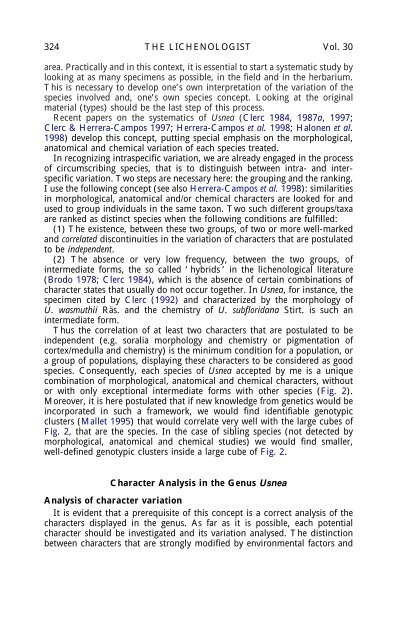SPECIES CONCEPTS IN THE GENUS USNEA (LICHENIZED ...
SPECIES CONCEPTS IN THE GENUS USNEA (LICHENIZED ...
SPECIES CONCEPTS IN THE GENUS USNEA (LICHENIZED ...
Create successful ePaper yourself
Turn your PDF publications into a flip-book with our unique Google optimized e-Paper software.
324 <strong>THE</strong> LICHENOLOGIST Vol. 30<br />
area. Practically and in this context, it is essential to start a systematic study by<br />
looking at as many specimens as possible, in the field and in the herbarium.<br />
This is necessary to develop one’s own interpretation of the variation of the<br />
species involved and, one’s own species concept. Looking at the original<br />
material (types) should be the last step of this process.<br />
Recent papers on the systematics of Usnea (Clerc 1984, 1987a, 1997;<br />
Clerc & Herrera-Campos 1997; Herrera-Campos et al. 1998; Halonen et al.<br />
1998) develop this concept, putting special emphasis on the morphological,<br />
anatomical and chemical variation of each species treated.<br />
In recognizing intraspecific variation, we are already engaged in the process<br />
of circumscribing species, that is to distinguish between intra- and interspecific<br />
variation. Two steps are necessary here: the grouping and the ranking.<br />
I use the following concept (see also Herrera-Campos et al. 1998): similarities<br />
in morphological, anatomical and/or chemical characters are looked for and<br />
used to group individuals in the same taxon. Two such different groups/taxa<br />
are ranked as distinct species when the following conditions are fulfilled:<br />
(1) The existence, between these two groups, of two or more well-marked<br />
and correlated discontinuities in the variation of characters that are postulated<br />
to be independent.<br />
(2) The absence or very low frequency, between the two groups, of<br />
intermediate forms, the so called ‘ hybrids ’ in the lichenological literature<br />
(Brodo 1978; Clerc 1984), which is the absence of certain combinations of<br />
character states that usually do not occur together. In Usnea, for instance, the<br />
specimen cited by Clerc (1992) and characterized by the morphology of<br />
U. wasmuthii Räs. and the chemistry of U. subfloridana Stirt. is such an<br />
intermediate form.<br />
Thus the correlation of at least two characters that are postulated to be<br />
independent (e.g. soralia morphology and chemistry or pigmentation of<br />
cortex/medulla and chemistry) is the minimum condition for a population, or<br />
a group of populations, displaying these characters to be considered as good<br />
species. Consequently, each species of Usnea accepted by me is a unique<br />
combination of morphological, anatomical and chemical characters, without<br />
or with only exceptional intermediate forms with other species (Fig. 2).<br />
Moreover, it is here postulated that if new knowledge from genetics would be<br />
incorporated in such a framework, we would find identifiable genotypic<br />
clusters (Mallet 1995) that would correlate very well with the large cubes of<br />
Fig. 2, that are the species. In the case of sibling species (not detected by<br />
morphological, anatomical and chemical studies) we would find smaller,<br />
well-defined genotypic clusters inside a large cube of Fig. 2.<br />
Character Analysis in the Genus Usnea<br />
Analysis of character variation<br />
It is evident that a prerequisite of this concept is a correct analysis of the<br />
characters displayed in the genus. As far as it is possible, each potential<br />
character should be investigated and its variation analysed. The distinction<br />
between characters that are strongly modified by environmental factors and

















